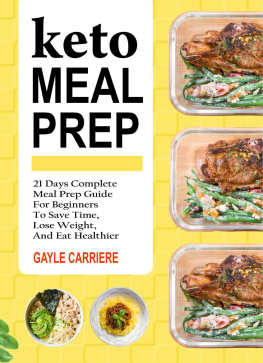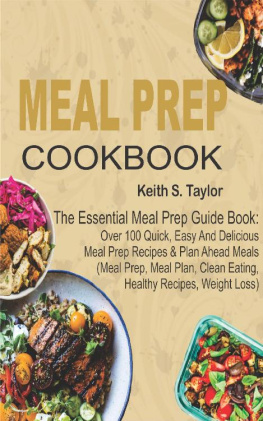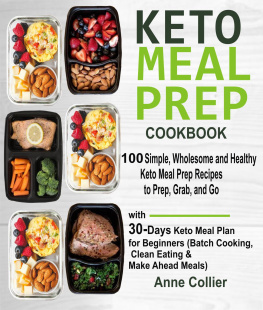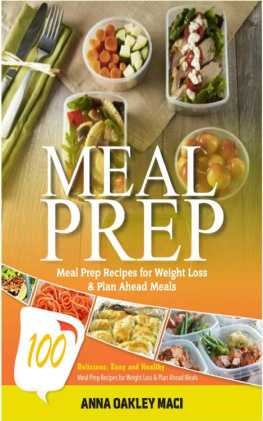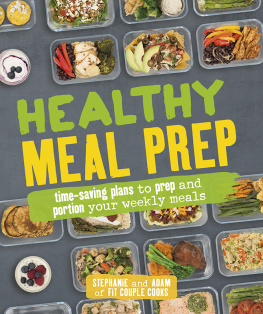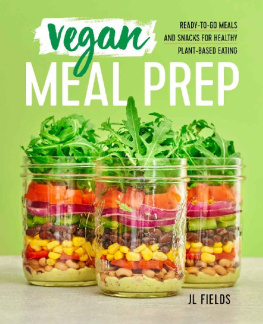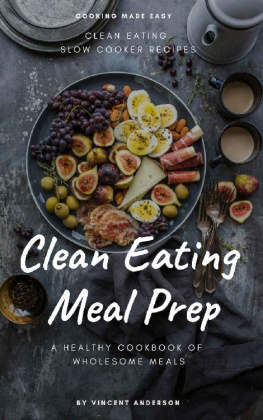The information in this book is for informational purposes only. While every effort has been made to provide proper nutritional information, this book is not meant to be a replacement for medical advice. Please speak to your primary care physician before starting any new diet or exercise program.
Introduction
Congratulations on downloading Meal Planning for Beginners , and thank you for doing so. Meal Planning for Beginners builds on the information provided in the companion book The Complete Mediterranean Diet for Beginners .
The following chapters will discuss the basics of meal planning and preparation. Soon, you will begin to enjoy healthy, delicious food prepared in your own home. Cook for your friends with confidence, and share your knowledge and skill of healthy cooking. Also, all of the recipes in this book have the macro grams figured to make building your own unique diet a snap.
You will also learn a different way of looking at calories. Counting macros vs. counting calories first became popular among weightlifters. The word "macros" refers to the macronutrients that make up our food. But more about that later. What's important is that this information will allow you to take control of the food you eat. You have the power to decide how you will fuel your body and with what.
The recipes in this book will follow the Mediterranean diet, which is rich in fresh fruits, vegetables, lean meats, seafood, whole grains, nuts, and olive oil. Recipes use Standard (imperial) measurements rather than metric. And, unless otherwise stated, all ingredients are freshno powdered garlic, no lemon juice out of a jar. They are just not as flavorful and do not save money.
Below is an outline of information and tools to help you reach your health goal:
- Introduction to macronutrients (often referred to as macros)
- Learning to count macros instead of simply counting calories
- Essential tools you will need to prepare and cook your meals
- Food selection and preparation
- Tips and techniques for the kitchen
- Meal planning for 21 days of delicious meals
- How to modify meals or recipes to help you reach your goals
- Over 80+ recipes with nutritional information
- Shopping guide and food list
- Tools to help you reach your goals
By cooking one or two meals a day, you will begin saving money, lose some weight, and maybe even develop a lifelong habit of good eating. Reviewing the ingredients in these recipes will help you make better choices when eating out.
There are plenty of books on this subject on the market; thanks again for choosing this one! Every effort was made to ensure it is full of as much useful information as possible. Please enjoy!
Chapter 1: What Are Macronutrients?
Remember the old food pyramid where the large, sturdy base was made up of bread, cereal, and other carbohydrates, six to eleven servings per day? The next level contained vegetables with three to five servings and fruits with two to four servings. Then, higher up but with smaller servings required are the dairy, meat, egg, nuts, and beans with two to three servings. This was all crowned by fats, oils, and sweets at the tip top. There are no serving suggestions but a warning that said: "USE SPARINGLY."
These guidelines sounded reasonable and made sense with what we knew about the body's use of nutrition. But, what the food pyramid didn't take into account is that most foods contain some carbs, protein, and fat. Our bodies need a balance of these nutrients to function efficiently by burning unwanted fat but not running out of energy.
Because of that first introduction to the basic food groups, there is a tendency to think of bread as strictly carbohydrate. Vegetables, fruits, and foods at the same level are thought of as health food. In other words, you can eat them as much as you want, while most types of meat, dairy, eggs, and nuts are good-for-you protein. On top of the pyramid is fat. "So, who eats a stick of butter? I shouldn't have a problem with fat!"
Fortunately, food science and our understanding of how we break down the components of food have come a long way since the first attempt to help people eat healthily. The old version of the food pyramid laid the groundwork for a variety of new views. Diets such as Paleo, Atkins, Keto, and others are formulated around increasing or decreasing the intake of carbs, proteins, and fats.
It turns out that those three main elements of carbohydrates, proteins, and fats are the three major nutrients contained in the food we eat. They are called macronutrients or macros for short.
Macros: The Building Blocks of Food
We have to re-learn the way we think of food. Instead of thinking of bread as a carb, an apple as health food, an egg as protein, or walnut as fat, we look at the percentage of all three macros in the food. What percentage of carbs, protein, and fat do the bread, apple, egg, and walnut contain?
It sounds complicated, but it really isn't. The percentages are conveniently contained on the product's nutrition label. For whole foods such as avocado or spaghetti squash, there are online nutrient calculators that you can use to figure the percentage spread.
Are you feeling overwhelmed? Don't be. By the time you finish these first few chapters, you will be a pro at figuring your macro percentages needed to reach your goals. You will also have the tools you need to find the proper food to fuel your body.
A Closer Look at Macronutrients
1. Carbohydrates :
You have probably heard about simple and complex carbohydrates. Here is a definition refresher.
Simple carbs break down fast and are absorbed quickly into the bloodstream. Some foods that are considered simple carbs are: refined sugar, fruit juice, candy, honey, white potatoes, white rice, refined white flour, alcohol, syrups, and sodas .
Complex carbs, on the other hand, are released slowly in the bloodstream over some time to help sustain your body's energy. Some foods that are considered complex carbs are: quinoa, brown rice, beans, lentils, oatmeal, and peas.
Are you familiar with the term sugar rush? That's what happens when your energy slumps, and you feel tired, so you eat a simple carb (say, a chocolate bar) to give you quick energy. Unfortunately, this quick fix of energy burns out as fast as it peaks. Then, you experience a sugar crash, which leaves you feeling worse than before.
Layering complex carbs with simple carbs is a better use of this nutritional building block. Cyclist will carbo-load with whole grains and other complex carbs several days before a big ride so that they have an extra store of energy (glycogen) in the muscles and liver. This prevents the athlete from running out of energy before finishing the race.
During the race, the athlete can consume some simple carbs to give him or her an extra boost of energy. This is not harmful because the athlete is burning up calories at an amazing rate.
For those of us sitting and watching the race, we don't need that sugary drink or sweet snack. Unfortunately, we are not burning many calories as we cheer on the riders.
Beware of cutting too many carbs out of your diet. If the body does not have enough carbohydrate to convert into glucose, it will start using protein and fat to do this process. This method of creating glucose has a waste product called ketones that build up in the body, causing the kidneys to work extra hard to clear out the waste.


